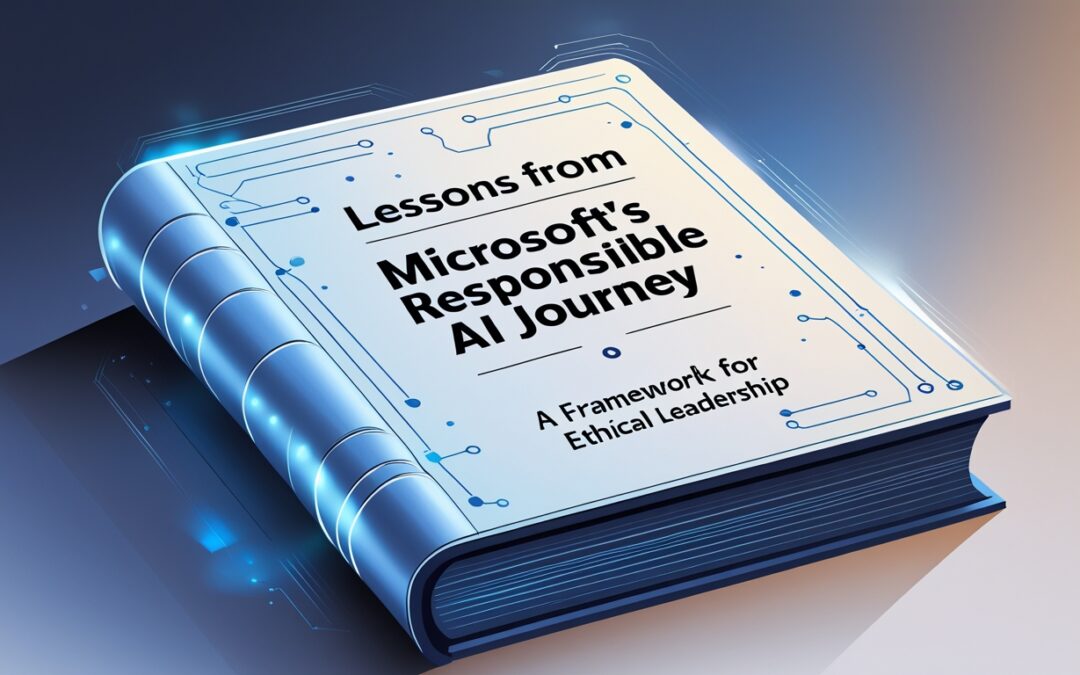When it comes to integrating AI at scale, Microsoft’s approach to responsible AI development and deployment offers a critical case study in what it means to combine innovation with ethical foresight. Dean Carignan’s reflections on the company’s journey reveal key lessons in governance, accountability, and operationalizing ethics within a fast-moving technological landscape. As someone who frequently explores the intersection of ethics and AI, I view Microsoft’s experience not just as a roadmap for large corporations but as a set of principles applicable to organizations of any size navigating AI’s transformative potential.
The lessons shared in Carignan’s review are more than a set of best practices—they are a wake-up call for business leaders. In today’s world, trust is the currency of long-term success when deploying AI. Companies that fail to embed responsibility into their innovation processes will inevitably face reputational, legal, and ethical consequences. Let’s break down what Microsoft’s responsible AI journey teaches us and how organizations can learn from it.
Lesson 1: AI Governance Must Be Embedded, Not Just Stated
One of the most important insights from Microsoft’s journey is their commitment to institutionalizing responsible AI through a robust governance framework. Governance at Microsoft isn’t just a policy document collecting dust on a shelf—it’s a dynamic system that evolves as the technology matures.
Microsoft’s Approach:
- Establishing a central AI ethics committee to address high-risk AI deployments and ensure that ethical guidelines are actively applied.
- Creating dedicated teams like the Aether Committee and the Office of Responsible AI, which collaborate across departments to assess and mitigate risks.
My Perspective:
Governance cannot be an afterthought or a separate initiative. It must be embedded within the core of every AI project from design to deployment. Too often, companies create ethics frameworks as reactive measures after facing public backlash or regulatory scrutiny. Microsoft’s proactive governance structure is what separates their responsible AI journey from those who “bolt on” ethics too late in the process.
Takeaway for Organizations:
Even small and medium-sized businesses implementing AI can benefit from this approach by creating cross-functional teams to regularly evaluate the ethical implications of their AI models. Whether it’s a two-person review board or a more formalized process, the key is ongoing engagement and continuous improvement.
Lesson 2: Accountability Cannot Be Delegated
Carignan’s insights underscore the critical role that accountability plays in responsible AI deployment. At Microsoft, responsibility for AI doesn’t rest solely on the shoulders of engineers or data scientists. Instead, accountability is shared across the organization, from leadership to product teams.
Microsoft’s Approach:
- Establishing clear lines of accountability for decisions related to AI model development, deployment, and outcomes.
- Integrating responsible AI principles into performance metrics and project evaluations to ensure teams take ownership of ethical considerations.
My Perspective:
This is where many organizations fall short. They treat AI ethics as an isolated function, expecting compliance officers or legal teams to carry the burden. But the reality is that ethical AI development requires shared responsibility. Business leaders must model this from the top down, demonstrating that ethics is integral to performance and success.
In my experience, the absence of accountability is a breeding ground for ethical lapses. When no one “owns” responsibility, unethical outcomes are often treated as unintended consequences rather than failures of foresight. Microsoft’s success highlights that ownership of ethical outcomes must be explicit and enforced across all levels.
Takeaway for Organizations:
Define clear accountability roles within every AI project. This doesn’t mean every employee needs to be an ethics expert, but they should understand how their work impacts overall AI outcomes and where to raise concerns.
Lesson 3: Operationalizing AI Ethics Requires Practical Tools, Not Just Ideals
While lofty ideals around ethical AI are important, they are meaningless without practical tools and processes that help teams implement those principles. Microsoft’s responsible AI journey emphasizes the importance of creating actionable mechanisms for evaluating and mitigating AI risks.
Microsoft’s Approach:
- Developing internal tools and resources like checklists, model risk assessments, and scenario planning frameworks to help teams apply ethical guidelines in practice.
- Continuously revising these tools as the company learns from past projects and new risks emerge.
My Perspective:
This is the difference between performative ethics and genuine ethical integration. Many organizations issue public commitments to responsible AI without equipping their teams with the tools necessary to deliver on those commitments. What Microsoft gets right is that operationalizing ethics requires practical guidance, consistent training, and iterative feedback mechanisms. Without this, even well-intentioned teams will default to focusing solely on performance and technical outcomes.
Takeaway for Organizations:
Small businesses may not have the resources to develop extensive in-house tools, but they can adapt existing resources—such as ethical AI checklists available through industry organizations—or partner with AI consultants to design lightweight processes that ensure ethical review is part of everyday decision-making.
Lesson 4: Responsible AI is a Continuous Journey, Not a One-Time Achievement
Carignan’s reflections make it clear that responsible AI development is an evolving process, not a milestone to be checked off. As technology advances, so do the challenges and risks associated with AI. Microsoft’s willingness to iterate and learn from failures sets a critical precedent.
Microsoft’s Approach:
- Acknowledging mistakes and using them as learning opportunities to refine policies and processes.
- Engaging in external collaboration with policymakers, academics, and industry experts to stay ahead of emerging ethical challenges.
My Perspective:
This lesson is crucial because many organizations view compliance as a finish line. Once they’ve developed an ethics policy or passed a regulatory audit, they assume their work is done. But AI is not static—neither should its oversight be. Companies must continuously adapt their ethical frameworks to address new risks, such as bias in training data or unintended algorithmic impacts.
In my role as a business ethics and AI consultant, I encourage organizations to embrace a mindset of continuous improvement. AI ethics is about evolution, not perfection. Companies must be willing to revisit decisions, acknowledge blind spots, and make course corrections when necessary.
Takeaway for Organizations:
Set regular review cycles to assess whether existing policies remain effective. Encourage teams to document lessons learned from projects and incorporate them into future initiatives.
The Broader Implications: Why Microsoft’s Journey Matters to Everyone
Microsoft’s responsible AI journey is not just a story about one company—it’s a blueprint for the entire business ecosystem. As AI becomes embedded in industries from healthcare to finance to manufacturing, the ethical challenges will only grow. What Microsoft demonstrates is that responsibility and innovation are not mutually exclusive. In fact, they go hand in hand.
Organizations that prioritize ethics will gain trust, competitive advantage, and resilience in the face of evolving regulatory landscapes. Those that neglect it will face public scrutiny, legal liabilities, and reputational damage.
Final Thoughts: Building Your Responsible AI Journey
As a business ethics speaker and AI consultant, I believe the most valuable lesson from Microsoft’s experience is that responsible AI isn’t just a technical issue—it’s a leadership issue. Business leaders must take ownership of ethical AI, not as a compliance requirement but as a strategic imperative.
Whether you’re leading a tech giant or a small startup, ask yourself these questions:
- Are your teams equipped with the tools and training needed to make responsible AI decisions?
- Have you established clear lines of accountability within your AI projects?
- Is your governance framework dynamic enough to evolve alongside AI advancements?
The answers to these questions will determine whether your organization thrives in the AI revolution—or becomes another cautionary tale of innovation without responsibility.
Because in the end, the true measure of success isn’t how fast you innovate—it’s how responsibly you lead.
Chuck Gallagher, Business Ethics Speaker and AI Consultant







